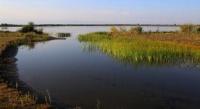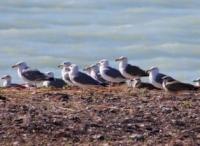Вы здесь
Tengiz lake.


Tours to Tengiz lake.
“Khargaldzhin... The distance of horse riding is six days, and in this way you can cover from three to four hundred miles. There are many islands and reeds in it. The water on one side, where the Nura River flowed into it, is fresh, and on the other, salty.”
Petr Ivanovich Rychkov.
Lakes of Korgalzhyn reserve.
Endorheic, bitterly salty Lake Tengiz is located at an altitude of 305 meters above sea level, located in the center of the Kazakh small hills (Sary-Arka), to the west of the Tengiz-Korgalzhyn depression, in the northern (Lake Small Tengiz) and western (Lake Big Tengiz) parts Korgalzhyn Nature Reserve in the Korgalzhyn district in the southwest of the Akmola region.
Tengiz (Kazakh Teniz - “sea, big lake”; Teniz, Dengiz, Nurinskoye). The lake is located in a tectonic depression. The banks are mostly low-lying. The food is mainly snow. The lake has an elongated shape. Various colonies of gulls and waders nest on the islands, as well as the rarest birds of our fauna - flamingos and pelicans.
The bottom of the lake is clayey, covered with gray and black silt with the smell of hydrogen sulfide. There is a drop in the lake level. The rivers Nura, Kulanotpes, Espesai (spring melt waters) flow into Tengiz. The bottom is flat. On the southern and southwestern sides it is solid (layers of sandstone), on the northern and northwestern sides it is silty.
Among the lakes of the former Soviet Union, the lake took 12th place. Today, the lake consists of two lakes - Big Tengiz and Small Tengiz, connected by a channel 24 kilometers long, which stretches from southwest to northeast.
It has a surface area of 1,590 square kilometers and a coastline length of 311 kilometers. The length of Lake Big Tengiz is 42.5 kilometers, its greatest width reaches 31 kilometers in the northern part and 32 kilometers in the southern part.
The length of Lake Small Tengiz is 12.5 kilometers, its greatest width reaches 21 kilometers in the northern part. The depth of the relict lake in 1945 was 8 meters, and in recent years - no more than 1.5 - 2.5. The bottom is flat, in some places it is composed of black silt, suitable for medicinal purposes.
In some years, a significant part of Tengiz dries out. The water contains mirabilite (salinity 3 - 12.7 g/m³, in the bay 18.2 g/m³). It freezes in the first ten days of December, opens in March (with the first thaw, depending on the temperature regime).
The shores of the lake from the northern, northwestern, western parts are flat, the southern and southwestern ones are with a sand bank up to 1.5-2.0 m in height. In 1957, Lake Tengiz was declared a hunting reserve for a period of 5 years.
Since 1968, the largest part of the area around the lake has been a nature protection zone and is part of the Kurgaldzhinsky reserve and hunting reserve. In 1976, the Tengiz-Kurgaldzhin lake system was included in the list of wetlands of international importance subject to the Ramsar Convention.
Since 2008, it has been located in the center of the territory of the Republican State Institution “Korgaldzhyn State Nature Reserve”. The lake is not attractive to game waterfowl (such as ducks and geese), but is an ideal nesting site for colonial species of shorebirds, gulls, terns, and even such rare birds as the pink flamingo.
The reed beds of the lake provide shelter for numerous waterfowl not only during the nesting period, but also during molting at the end of summer and during spring and autumn migrations. In the previously existing conservation zone, biologists counted 340 plant species, 318 bird species and 50 mammal species.
Among others, we can mention saigas and steppe wolves. 500 pairs of endangered Dalmatian pelicans, up to 14,000 pairs of pink flamingos and 1,300 pairs of great gulls nest on the islands of Lake Tengiz. The steppe eagle and the Inumidian crane nest in the steppes around the lake.
There is no fish, although on the coast you can often find dried large carcasses of fish (carp, large crucian carp) washed up by the waves and brought from the river delta. Lake Tengiz (depending on the hydrological regime) contains more than 20 isolated islands, some of which are suitable sites for nesting colonies of pink flamingos (this is the northernmost location of a breeding colony of pink flamingos in the world).
Between 2006 and 2011, approximately 45,000 individuals of this species were counted. By 2015, the number had decreased noticeably (no more than 15,000). In the delta of the Nura River, which flows into the lake, a large number of waterfowl also accumulate (geese, ducks, Dalmatian pelican listed in the Red Book of Kazakhstan, little and great white, gray heron, waders, terns).
Reed thickets in the delta of the Nura River created favorable conditions for numerous waterfowl not only for nesting, but also during molting and during the spring-autumn migration. More than 350 species of terrestrial and more than 180 species of aquatic vascular plants have been recorded in the region.
Of the 350 species of birds recorded here, more than 120 species form the wetland group. Their total number during the period of molting, nesting and spring-autumn migration exceeds 5,000,000 individuals. 45 species of mammals have also been recorded.
Among them is a rare species with a sharply declining population - the saiga antelope. On the western, southwestern and southern sides of the lake there is the Kazakh small hill on which steppe eagles make their nests.
There is no surface vegetation at all on the bitterly salty Tengiz. In some places, the shores are covered with a layer of seeds of various semi-aquatic plants, as well as algae brought here by rivers and forming a kind of “vegetative mat”.
In 1976, for the first time in the history of Soviet manned cosmonautics, the crew of the Soyuz-23 expedition, a crew of two cosmonauts – Zudov and Rozhdestvensky, was forced to splash down on Lake Tengiz in 1976.
The dramatic landing on the lake took place late at night in a snowstorm 2 kilometers from the shore at a temperature of −20 °C. The exit hatch ended up in the water, and the cosmonauts were in the descent vehicle for about 12 hours.
It was possible to save the astronauts only by towing the descent capsule to shore using a helicopter.
Geographic coordinates of Lake Big Tengiz: N50°24'07 E68°52'22
Geographic coordinates of Lake Maly Tengiz: N50°41'08 E69°24'25
Authority:
Alexander Petrov.
https://ru.wikipedia.org/wiki/%D0%A2%D0%B5%D0%BD%D0%B3%D0%B8%D0%B7_(%D0%BE%D0%B7%D0%B5%D1%80%D0%BE)
"Korgalzhyn State Nature Reserve". Sidorova T.
"Reserves of Central Asia and Kazakhstan." Publishing house "Mysl". 1990 Edited by V.E. Sokolova, E.E. Syroechkovsky.
Photos by:
Alexander Petrov.







